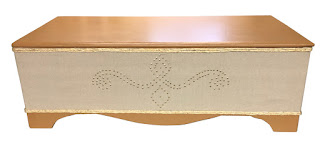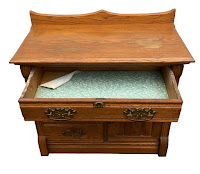 |
| Cedar Chest Before |
 |
| Cedar Chest After |
The refinishing process is tedious, but when we get a painted item of furniture that the customer wants stained, it is necessary that every spec of paint is removed, because once it is stained, if not removed, that paint will be visible. Therefore, the stripping and sanding process must be done with intense precision and close attention to detail. It is easy to overlook the small crevices, but they too must be stripped of any and all remnants of paint or any other old finish. That’s where the wood carving tools come in quite handy as they allow us to get into the tiny spots that paint can get trapped.
You never really know what the wood will reveal once the paint has been removed, but as with most cedar chests, this one was was quite beautiful. It had accent strips on the front with wood “buttons” for a bit if decorative flair. It has great lines and a lift-up shelf not the inside. It was also a Lane, so a commonly known brand name that many people have experience with. Upon research, I discovered that Lane cedar chests have the date they were made stamped on the underside of the chest in reverse. (Therefore if your cedar chest’s serial number is 649010, it was built on January 9, 1946).
 |
| Cedar Chest Before |
 |
| Cedar Chest After |
Not all cedar chests have a serial or date stamp on the bottom as there were many manufacturers of cedar chests across the country. Lane is a popular brand that offers a variety of styles and sizes.
Upon completion, this lovely Lane was once again in its original condition, showing off its many tones of wood with that easily recognizable cedar fragrance that we love and moths hate!
 |
| Finished Cedar Chest |
https://finalefurniture.blogspot.com/2019/11/solid-cedar-chest.html
https://finalefurniture.blogspot.com/2016/08/1948-lane-cedar-chest_22.html
https://finalefurniture.blogspot.com/2015/04/elegant-cedar-chest-revival.html
https://finalefurniture.blogspot.com/2013/12/1945-lane-waterfall-cedar-chest.html
https://finalefurniture.blogspot.com/2012/06/my-waterfall-cedar-chest.html






























